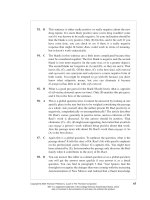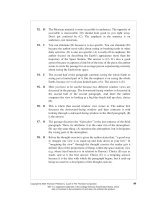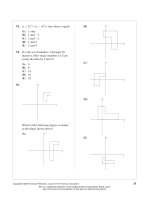SAT practise test 10000 part 5 pdf
Bạn đang xem bản rút gọn của tài liệu. Xem và tải ngay bản đầy đủ của tài liệu tại đây (118.13 KB, 8 trang )
3.
2
3
4
5
5
(A)
1
3
(B)
8
15
(C)
5
6
(D)
15
8
(E)
6
5
4.
If 3y 5 x and y 5
10
z
, what is the value of
z when x 5 3?
(A)1
(B)3
(C)5
(D)7
(E)10
5. If y 5 mx 1 b where m is a negative
constant and b is a positive constant,
which of the following could be a possible
graph of y 5 mx 1 b?
(A)
(B)
(C)
(D)
33Copyright © 2005 Thomson Peterson’s, a part of The Thomson Corporaton
SAT is a registered trademark of the College Entrance Examination Board, which
was not involved in the production of and does not endorse this product.
6.
Small
(S)
Medium
(M)
Large
(L)
Hats (H) $8 $12 $12
Shirts (SH) $12 $12 $14
Hat & Shirt Prices at Moe’s
If Moe’s has a 25% off sale on medium-
sized items, how much would it cost, in
dollars, to order 2 H-M, 2 H-L, and
1SH-M?
(A)51
(B)53
(C)55
(D)56
(E)58
7.
If 5
=
x 1 15 5 30, then x 5
(A)9
(B)10
(C)12
(D)14
(E)15
8.
x
2
2 x 2 12
2x
2
1 2x 2 12
5
(A)
x 2 2
x 2 4
(B)
3
~
x 2 2
!
x 2 4
(C)
4
~
x 2 3
!
x 2 2
(D)
x 2 4
2
~
x 2 2
!
(E)
4
~
x 2 3
!
3
~
x 2 2
!
9. If f(x) 5 x
2
is graphed on a standard
xy-axis and then the graph is rotated 90°
clockwise, which of the following graphs
would result?
(A)
(B)
(C)
(D)
(E)
34 Copyright © 2005 Thomson Peterson’s, a part of The Thomson Corporaton
SAT is a registered trademark of the College Entrance Examination Board, which
was not involved in the production of and does not endorse this product.
10. For which of the following ordered pairs
(x,y)isx 2 y . 2 and x 1 y . 4?
(A) (1,3)
(B) (2,3)
(C) (4,0)
(D) (3,2)
(E) (4,1)
11.
If x and y are positive integers and
x
y
5
1
2
,
then x 1 y 5
(A)3x
(B)5x
(C) y
(D)2y
(E)3y
12. Quentin buys three hot dogs with a
ten-dollar bill and receives seven dollars
and thirty-four cents in change. If the sales
tax is seven cents per dollar (rounding to
the nearest penny), which of the following
choices, in cents, is closest to the actual
price of a hot dog?
(A)78
(B)82
(C)86
(D)89
(E)92
13.
If the two triangles above are congruent
then b 5
(A)30
(B)40
(C)45
(D)60
(E) It cannot be determined.
14.
What is the area of the above figure?
(A)
2
=
2
(B)4
(C)8
(D)9
(E)12
35Copyright © 2005 Thomson Peterson’s, a part of The Thomson Corporaton
SAT is a registered trademark of the College Entrance Examination Board, which
was not involved in the production of and does not endorse this product.
Questions 15–16 refer to the following chart.
15. Which year had the least percentage
difference in reported incidence of flu and
cold?
(A) 1960
(B) 1970
(C) 1980
(D) 1990
(E) 2000
16. In percentage terms, in what decade was
the number of reported cold cases about
25% greater than the number of reported
flu cases?
(A) 1960
(B) 1970
(C) 1980
(D) 1990
(E) 2000
17. If l
1
i l
2
, then which of the following pairs
of angles must be congruent?
I. 6 and 12
II. 2 and 9
III. 4 and 10
(A) I only
(B) II only
(C) III only
(D) II and III only
(E) I and II only
18. If 2a
2b
2c
is a positive integer, and a, b,
and c are integers, then
(A) a must be negative.
(B) b must be negative.
(C) c must be negative.
(D) b must be an even positive integer.
(E) None of the above.
36 Copyright © 2005 Thomson Peterson’s, a part of The Thomson Corporaton
SAT is a registered trademark of the College Entrance Examination Board, which
was not involved in the production of and does not endorse this product.
19.
If all the line segments in the above figure
are congruent, then
(A) a . b
(B) a , b
(C)2a 5 b
(D) a 5 b
(E) It cannot be determined.
20. Two boys and two girls are assigned to sit
at a five-seat circular table, where the
seats are numbered one through five. If
neither boy can sit by the open seat, seat
3, how many different seating arrange-
ments are possible?
(A)2
(B)3
(C)4
(D)5
(E)6
21. There are 150 students in math courses at
Dagmar High School. 73 are in geometry,
62 are in algebra, and 52 are in neither.
How many students are in both geometry
and algebra?
(A)32
(B)33
(C)35
(D)36
(E)37
STOP
Do not proceed to the next section until time is up.
37Copyright © 2005 Thomson Peterson’s, a part of The Thomson Corporaton
SAT is a registered trademark of the College Entrance Examination Board, which
was not involved in the production of and does not endorse this product.
Section 6
16 Questions j Time—20 Minutes
Directions: Each passage below is followed by a set of questions. Read each passage, then
answer the accompanying questions, basing your answers on what is stated or implied in the
passage and any introductory material provided. Mark the letter of your choice on the answer
sheet that best corresponds to the correct answer.
Line In 1953, Watson and Crick unlocked the
structure of the DNA molecule and set
into motion the modern study of genetics.
This advance allowed our study of life to
go beyond the so-called wet and dirty
realm of biology, the complicated labora-
tory study of proteins, cells, organelles,
ions, and lipids. The study of life could
now be performed with more abstract
methods of analysis. By discovering the
basic structure of DNA, we had received
our first glance into the information-based
realm locked inside the genetic code.
1. Which of the following does the passage
discuss as a change that the discovery of
DNA brought to the study of life?
(A) The study of lipids and proteins
became irrelevant.
(B) New and more abstract methods of
study were possible.
(C) Biology could then focus on mol-
ecules rather than cells.
(D) Modern genetics matured past its
Mendelian roots.
(E) Information-based study of genes
became obsolete.
2. The passage uses the phrase “wet and
dirty” (line 5) to mean
(A) haphazard guessing about the genetic
code.
(B) the work of Watson and Crick in
discovering DNA.
(C) information-based biological
research.
(D) the study of the genetic code.
(E) involved laboratory practices in
studying basic biological entities.
Although little-known today in the United
States, Clark Saunders (1859–1941) cast a large
shadow in the first several decades of the
twentieth century, writing many widely read
books on Native American, Spanish, and Anglo
folklore. He also wrote extensively on the
different cultures of California, the Sierras, and
the Southwest. He was a major and influential
contributor to Sunset Magazine in its early
years. In his day, Saunders was important for
introducing much of the American public to a
person-sized understanding of the “Old West.”
(5)
(10)
38 Copyright © 2005 Thomson Peterson’s, a part of The Thomson Corporaton
SAT is a registered trademark of the College Entrance Examination Board, which
was not involved in the production of and does not endorse this product.
3. The passage presents Saunders as a(n)
(A) influential contemporary western
writer.
(B) important historian of the West.
(C) a specialist of Native American
studies.
(D) widely read author in his own day.
(E) the first editor of Sunset Magazine.
The history of rock and roll is inseparable from
the development of blues and gospel music in
the southeastern United States. Though the
genre gained mass appeal through legendary
figures such as Elvis Presley or the wildly
popular Beatles, the musical roots of rock and
roll extend far before such groups. In fact,
many of the groups who popularized rock and
roll were consciously attempting to emulate the
work of blues greats such as B. B. King or
Muddy Waters. The Rolling Stones are a good
example of this trend, which developed in the
late fifties and early sixties. The Rolling Stones,
both then and now, have always explicitly
stated their admiration and imitation of blues
greats.
4. B. B. King is used in this passage as an
example of a
(A) blues artist who was emulated by
early rock bands.
(B) musical artist influenced by Elvis
Presley.
(C) musician who incorporated aspects
of rock and roll.
(D) musician who often played with
Muddy Waters.
(E) gospel singer who influenced the
Rolling Stones.
The following two passages deal with the
political movements working for the woman’s
vote in America.
Passage 1
Line The first organized assertion of woman’s
rights in the United States was made at the
Seneca Falls convention in 1848. The
convention, though, had little immediate
impact because of the national issues that
would soon embroil the country. The
contentious debates involving slavery and
state’s rights that preceded the Civil War
soon took center stage in national debates.
Thus woman’s rights issues would have to
wait until the war and its antecedent
problems had been addressed before they
would be addressed.
In 1869, two organizations were
formed that would play important roles in
securing the woman’s right to vote. The
first was the American Woman’s Suffrage
Association (AWSA). Leaving federal and
constitutional issues aside, the AWSA
focused their attention on state-level
politics. They also restricted their ambi-
tions to securing the woman’s vote and
downplayed discussion of women’s full
equality. Taking a different track, the
National Woman’s Suffrage Association
(NWSA), led by Elizabeth Stanton and
Susan B. Anthony, believed that the only
way to assure the long-term security of the
woman’s vote was to ground it in the
constitution. The NWSA challenged the
exclusion of woman from the Fifteenth
Amendment, the amendment that
extended the vote to African-American
men. Furthermore, the NWSA linked the
fight for suffrage with other inequalities
faced by woman, such as marriage laws,
which greatly disadvantaged women.
(5)
(10)
(15)
(20)
(25)
(30)
(35)
39Copyright © 2005 Thomson Peterson’s, a part of The Thomson Corporaton
SAT is a registered trademark of the College Entrance Examination Board, which
was not involved in the production of and does not endorse this product.
By the late 1880s the differences that
separated the two organizations had
receded in importance as the women’s
movement had become a substantial and
broad-based political force in the country.
In 1890, the two organizations joined
forces under the title of the National
American Woman’s Suffrage Association
(NAWSA). The NAWSA would go on to
play a vital role in the further fight to
achieve the woman’s vote.
Passage 2
In 1920, when Tennessee became the
thirty-eighth state to approve the constitu-
tional amendment securing the woman’s
right to vote, woman’s suffrage became
enshrined in the constitution. But wom-
an’s suffrage did not happen in one fell
swoop. The success of the woman’s
suffrage movement was the story of a
number of partial victories that led to the
explicit endorsement of the woman’s right
to vote in the constitution.
As early as the 1870s and 1880s,
women had begun to win the right to vote
in local affairs such as municipal elections,
school board elections, or prohibition
measures. These “partial suffrages”
demonstrated that women could in fact
responsibly and reasonably participate in
a representative democracy (at least as
voters). Once such successes were
achieved and maintained over a period of
time, restricting the full voting rights of
woman became more and more suspect. If
women were helping decide who was on
the local school board, why should they
not also have a voice in deciding who was
president of the country? Such questions
became more difficult for non-suffragists
to answer, and thus the logic of restricting
the woman’s vote began to crumble.
5. The word “antecedent” in line 11 can best
be replaced by
(A) antebellum.
(B) referent.
(C) causal.
(D) subsequent.
(E) abolitionist.
6. Which of the following does the first
passage say was the first organized push
for woman’s suffrage?
(A) formation of the National Woman’s
Suffrage Association
(B) formation of the American Woman’s
Suffrage Association
(C) convening of the Seneca Falls
convention
(D) Tennessee passing the Twenty-Second
Amendment
(E) “partial suffrages” of local woman’s
suffrage efforts
7. What national event does the first passage
cite as pushing woman’s voting rights to
the background of the national conscious-
ness?
(A) Civil War
(B) Suffrage movement
(C) Prohibition
(D) Passage of the Fifteenth Amendment
(E) World War I
8. According to the first passage, the
National Woman’s Suffrage Association
focused their efforts on
(A) local elections.
(B) constitutional issues.
(C) prohibition efforts.
(D) school board elections.
(E) state elections.
(40)
(45)
(50)
(55)
(60)
(65)
(70)
(75)
40 Copyright © 2005 Thomson Peterson’s, a part of The Thomson Corporaton
SAT is a registered trademark of the College Entrance Examination Board, which
was not involved in the production of and does not endorse this product.









